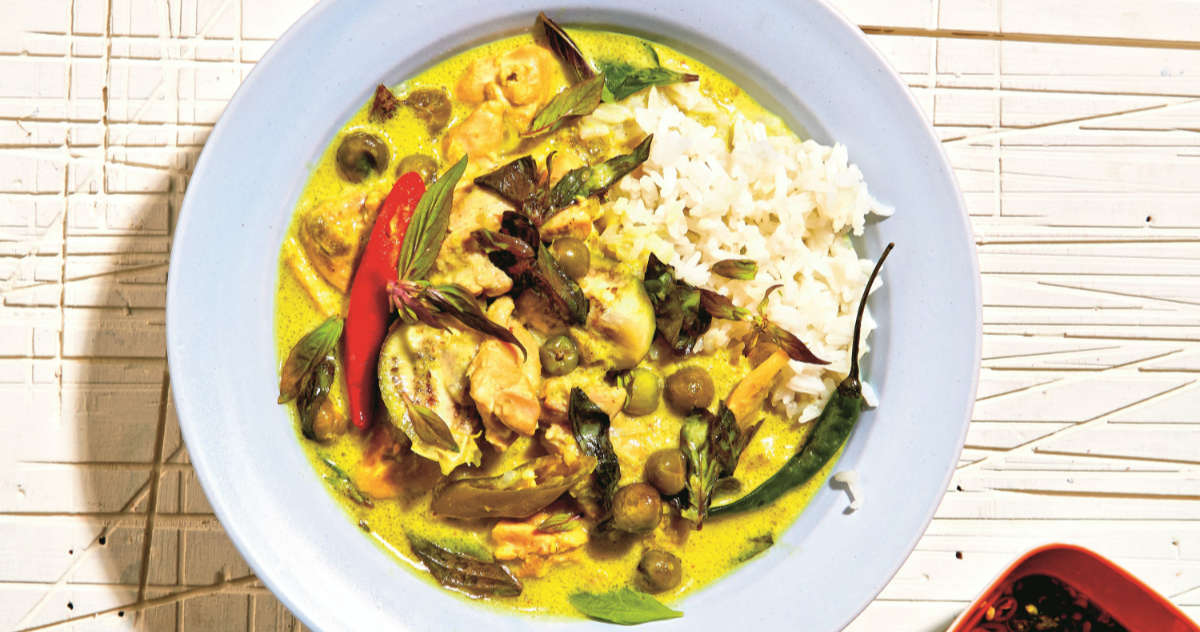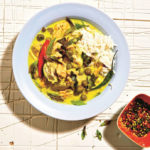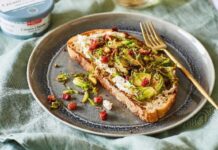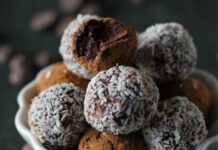“How many times have you seen a green curry described as ‘mild’ or ‘sweet’? It infuriates me, and I’ve seen it done a thousand times,” declares food writer Kay Plunkett-Hogge. “And it isn’t just Thai restaurants in Britain that do it. Several years ago, I took a boat down the river from Ayutthaya to Bangkok. As luck would have it, my husband and I were the only passengers and, after a long conversation with the crew, primarily about food, they promised to bin out the bland version they serve farang and to make it properly. And jolly good it was too: Lively, fiery and delicious.
“This dish is all about bright, green flavours. The chlorophyll in the herbs should sing out like Maria Callas. This matter of freshness is the other reason for a poor green curry. Once the paste is made, it doesn’t matter how many preservatives they use in it, the inherent green freshness will deteriorate quickly, so a store-bought keow waan paste will always disappoint,” she adds.
“This is the one curry paste you should always make from scratch. It’s also the easiest, the best one to learn and practise on, and the best way to remember why the green curry became famous in the first place.”
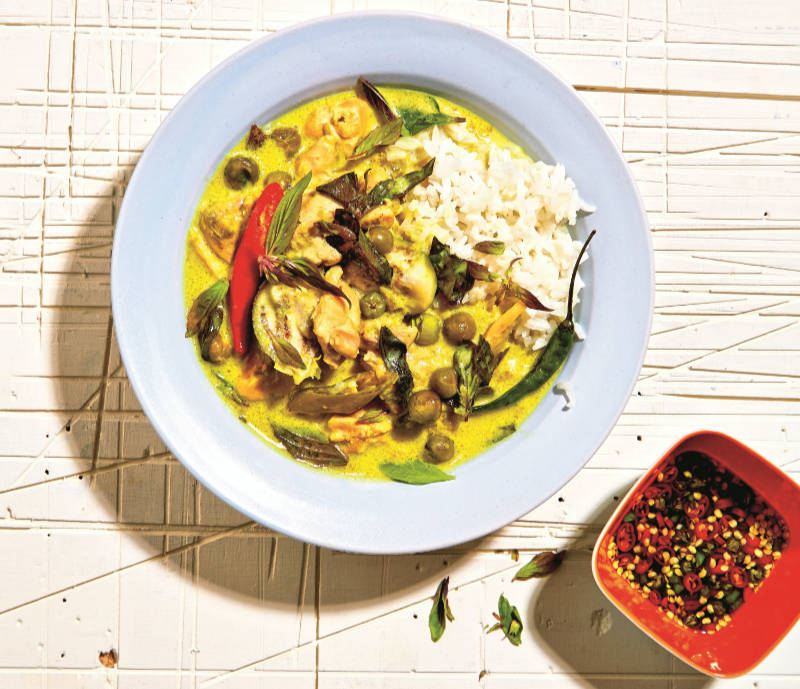
Classic green chicken curry
Equipment
- Food processor or a blender
- Pestle and mortar
- Saucepan or wok
Ingredients
For the paste
- 1/2 tsp coriander seeds
- 1/2 tsp cumin seeds
- 1 tsp white peppercorns
- a good pinch of salt
- 1 tbsp finely chopped galangal
- 1 tbsp finely chopped lemongrass
- 2 Thai shallots or 1 regular shallot, peeled and finely chopped
- 12 green Thai bird's eye chillies de-stemmed and chopped
- 2 long green chillies de-stemmed and finely chopped
- 4 tbsp finely chopped fresh coriander root with some stem attached
- 1 garlic clove peeled and finely chopped
- 2 cm piece of fresh turmeric finely chopped
- 1 kaffir lime zest
- 1 tsp kapi (shrimp paste)
For the curry
- 2 tbsp vegetable oil
- 400 ml coconut milk
- 350 g chicken thighs cut into 2cm dice
- 2 tbsp nam pla fish sauce
- A pinch of caster sugar (optional)
- 65 g pea aubergines (these are available from Amazon and certain supermarkets)
- 2 Thai round aubergines cut into quarters
- 100 g bamboo shoots chopped (canned or vacuum-packed)
- 2 long red chillies diagonally sliced into 3 pieces
- A large handful of Thai sweet basil
- 1 long orange chilli (optional)
Method
- To make the paste: Pound all the ingredients in a pestle and mortar (starting with hardest ingredients first, as listed, working down to the softest), until you have a uniform, close-textured paste. If it’s not completely smooth, don’t worry. If you prefer to use a food processor or a blender, again work from the hardest to the softest ingredients, and add about one tablespoon water or more to bring the paste together.
- To make the curry: Heat the oil in a wok or saucepan and fry the paste until it smells fragrant, about one minute. Add half of the coconut milk, bring to the boil slowly, stirring to dissolve the paste. Once the paste has dissolved, let the coconut milk simmer a little until you see oil appearing on the surface. Then add 200ml of water and bring to the boil.
- Add the chicken and bring back to the boil, then add the rest of the coconut milk. Bring back to the boil and simmer for about six minutes. Add the nam pla and the sugar, if using. Taste and adjust the seasoning. If it seems a little thick, add a little more water – you want a soupiness, not a thick gravy.
- Add the aubergines, the bamboo shoots and one of the long red chillies. Simmer for another three minutes or so. Taste – you want this to taste vibrant, hot, salty and herbaceous. Add the basil, the remaining red chilli and the whole orange chilli if you have one, and serve with some jasmine rice and Nam Pla Prik (Fish Sauce with Chillies).
Nutrition
Note:
Sometimes, you cannot find coriander root. If you can’t, replace it with the same amount of coriander stem. It won’t taste quite the same, and it will give you a greener curry, but it works very well.
If you cannot find kaffir limes, leave the zest out of the recipe altogether.
No matter how many times you make this dish, the colour of the curry will vary. This is down to the quality and freshness of your ingredients. To punch up the green, add a few extra chopped coriander stems to the paste. A bit of a cheat, but it looks fabulous.
Baan: Recipes And Stories From My Thai Home by Kay Plunkett-Hogge, photography by Louise Hagger, is published by Pavilion Books.
Wise Living Magazine may receive a small commission to help support the running of this site from purchases made from links on this page. Affiliate links do not influence our editorial or articles published by Wise Living.























































